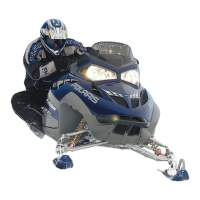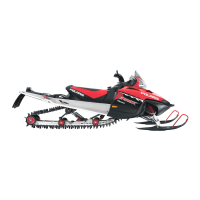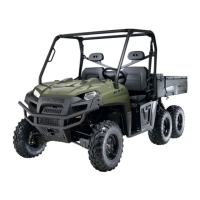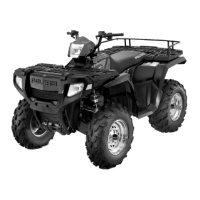What to do for slow, easy clutch engagement on my Polaris Offroad Vehicle?
- RRyan MarshallSep 23, 2025
For slow, easy clutch engagement on your Polaris Offroad Vehicle, use fast, aggressive throttle to engage the clutch.
What to do for slow, easy clutch engagement on my Polaris Offroad Vehicle?
For slow, easy clutch engagement on your Polaris Offroad Vehicle, use fast, aggressive throttle to engage the clutch.
Why is my Polaris 2005 RMK 900 Offroad Vehicle engine lacking power?
If your Polaris Offroad Vehicle engine lacks power, it could be due to a fouled or defective spark plug. In this case, replace the plug. Alternatively, the fuel filter might be the cause, leading to a loss of high RPM power, so it is recommended to SEE YOUR DEALER. Incorrect clutching could also be a reason, so it is recommended to SEE YOUR DEALER.
Why does my Polaris 2005 RMK 900 have poor low RPM performance?
Poor low RPM performance in your Polaris Offroad Vehicle can stem from several issues. A worn drive belt could be the cause, so inspect and replace it as needed. Excessive belt/sheave clearance might also be the problem, so it is recommended to SEE YOUR DEALER. Additionally, a loose torque stop can contribute to this issue, so inspect and adjust it. A sticky clutch is another possibility, so it is recommended to SEE YOUR DEALER. Finally, poor fuel quality can lead to poor performance, so use premium fuel (91 octane or higher).
What to do if my Polaris Offroad Vehicle engine doesn’t turn?
If your Polaris Offroad Vehicle engine doesn’t turn, it could be seized. Seizure is a result of poor lubrication, inadequate fuel supply, broken parts or improper cooling, so it is recommended to SEE YOUR DEALER. Another potential cause is hydrostatic lock, where fuel may have entered the crankcase while the vehicle was standing or being transported, so it is recommended to SEE YOUR DEALER to correct the cause. Drain plug(s) are located on the lower crankcase for emergency draining.
What to do if my Polaris Offroad Vehicle has poor engine performance?
If your Polaris Offroad Vehicle has poor engine performance, check for fouled plugs or water, ice, or dirt in the gas tank or fuel line.
What to do if I am driving at low RPM with my Polaris 2005 RMK 900 Offroad Vehicle?
If you are driving your Polaris Offroad Vehicle at low RPM, drive at higher RPMs. Gear the machine down. Check belt deflection.
Why is the steering heavy on my Polaris 2005 RMK 900 Offroad Vehicle?
If the steering on your Polaris Offroad Vehicle feels heavy, check the skags and skis for damage. Inspect for binding front suspension shafts and steering components, grease all pivot points (elevate the front of the machine). Verify the sag dimension (see set-up decal). Adjust torsion spring blocks or install optional torsion springs to achieve correct sag dimensions. Decrease IFS preload (premium only) (see page 44).
Why does my Polaris 2005 RMK 900 dart from side to side?
If your Polaris Offroad Vehicle darts from side to side, ensure the skis are properly aligned (see page 103). Check for binding front suspension shafts and steering components, grease all pivot points (elevate the front of the machine). Ensure the skags are straight on the skis.
What should I do if my Polaris Offroad Vehicle engine backfires but fails to start?
If your Polaris Offroad Vehicle engine backfires but fails to start, ensure the spark plug wires are correctly installed on the corresponding cylinder.
How to address erratic engine operation during acceleration in my Polaris Offroad Vehicle?
If your Polaris Offroad Vehicle experiences erratic engine operation during acceleration or load variations, it could be due to drive clutch binding, so it is recommended to SEE YOUR DEALER. Alternatively, a driven clutch malfunction might be the cause, so it is recommended to SEE YOUR DEALER.
| Brand | Polaris |
|---|---|
| Model | 2005 RMK 900 |
| Category | Offroad Vehicle |
| Language | English |
Key guidance for new owners regarding manual usage and vehicle care.
Recording essential numbers for registration, service, and identification.
Essential instructions and precautions for safe snowmobile operation.
Identification and understanding of warning decals on the snowmobile.
Adjustable steering system to fit various riding styles.
Explanation of the Multi-Function Display (MFD) and its various functions.
Schedule and overview of required service intervals for optimal performance.
Routine upkeep procedures for various snowmobile systems.
Guide to identifying and resolving common engine operational problems.
Diagnosing and resolving issues related to suspension performance.
Procedures for obtaining warranty service and contacting customer support.
Details of the one-year limited warranty coverage and exclusions.











